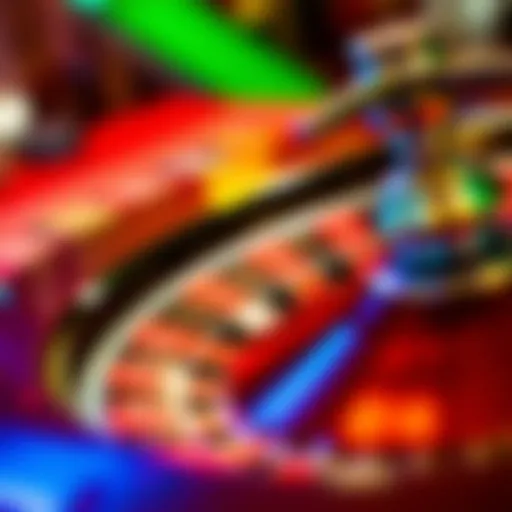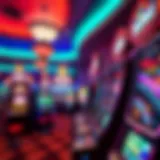The Spectacular Vegas Light Show: A Comprehensive Insight
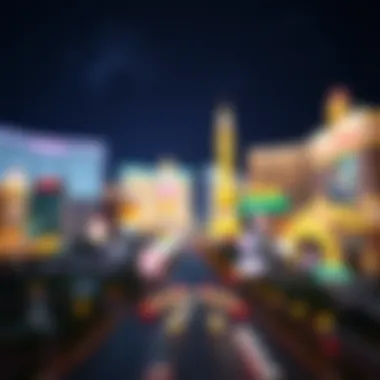

Intro
Las Vegas, a city that never sleeps, shines brighter than a diamond ring in the sun. When the sun goes down, the skyline transforms into a canvas of light and color, creating an awe-inspiring spectacle known as the Vegas light show. This dazzling phenomenon embodies the spirit of the city, captivating tourists and locals alike. But what goes into creating this breathtaking visual extravaganza? This article will explore the many layers that compose this unique display, from its historical roots to the cutting-edge technology that fuels its brilliance.
The narrative begins with a look back at the origins of the Vegas light show, unfolding like a well-worn map guiding us through the path of innovation. Understanding its evolution reveals how it reflects the shifting landscape of entertainment, art, and human ingenuity in Las Vegas. The vibrancy of the lights is not just about aesthetics; it's deeply woven into the fabric of the culture and economy of this legendary city.
As we journey through each section, we’ll discuss notable advancements in lighting technology that have set the stage for today's shows. Cultural influences will be examined as well, showcasing how various artistic expressions have contributed to this phenomenon. Along the way, we will highlight the effects on tourism and its role in building the city's infamous reputation.
In this exploration, we aim to provide a well-rounded understanding of the Vegas light show—an event where art meets economics, and history dances with innovation. The discussion will culminate in a synthesis of insights, enabling readers to appreciate not just the beauty of the lights, but the story that lies beneath their flickering glow.
Prelude to the Vegas Light Show
The Las Vegas light show is not merely a display of luminance; it’s an intricate tapestry woven with threads of history, culture, and artistic endeavor. This unique phenomenon stands as a testament to the evolution of entertainment, drawing millions of visitors each year to witness its brilliance. In this exploration, we seek to illuminate the significance of these captivating light displays and their remarkable ability to transcend the ordinary, offering viewers a glimpse into the soul of the city.
The Charm of Las Vegas
Las Vegas, with its dazzling array of lights, thrives on an image that’s larger than life. The charm of this city lies in its paradox: it’s both a playground for adults and a canvas for artistic expression. Every street corner and casino marquee serves as a vibrant beacon, inviting wanderers to partake in the experience. The golden glow of the Strip is an alluring siren song; it captures the essence of indulgence and thrill.
Think about the first time you saw the iconic welcome sign shimmering against the night sky. It’s not just a marker; it's a promise of excitement, a gateway to a fleeting world where the ordinary is left behind.
Yet, this charm is anchored deeply in the city’s identity. The light shows are not merely aesthetic; they reflect the dreams and aspirations that fuel both visitors and residents. They symbolize hope in the land of chance, echoing the sentiment that in Las Vegas, anything is possible.
Significance of Light in Entertainment
Light plays a pivotal role in entertainment, serving as both a guide and a protagonist in the performances it illuminates. Within the context of Las Vegas, this significance is heightened. The city’s entertainment ecosystem rests on the interplay between light and spectacle, crafting an experience that is richly layered and profoundly engaging.
From the scintillating visuals of Cirque du Soleil to the immersive art installations that dot the landscape, light acts as the connective tissue binding these experiences together. It conveys emotion, sets mood, and heightens anticipation, building a narrative that resonates with onlookers.
Moreover, the significance of light extends beyond sheer enjoyment. It shapes social interactions, often becoming the backdrop for life’s pivotal moments—weddings, anniversaries, and personal victories. In such a setting, light moves from being an accessory to becoming an integral part of the story, crafting memories that linger long after the show has ended.
"In Vegas, the lights speak a language of their own—each flicker and flare telling a story of hope, risk, and revelry."
In summary, the importance of the Vegas light show transcends the boundaries of mere entertainment. It encapsulates the city's very essence, intertwining the charm of Las Vegas with a deeper cultural and emotional significance. By examining its various facets, we begin to appreciate not just what is visible, but what lies beneath the surface—an intricate dance of light that reveals the heart of a dynamic landscape.
Historical Context of Light Displays in Las Vegas
Understanding the historical context of light displays in Las Vegas is crucial for appreciating the culture and identity this city has cultivated over the decades. The neon lights and vibrant displays hold more than just aesthetic appeal; they symbolize the spirit and evolution of a place that thrives on entertainment and artistry. During the formative years of Las Vegas, light was not only a means of attracting visitors but also served as a canvas for creative expression. This section delves into the early beginnings of neon displays, followed by their evolution into the sophisticated light shows present today.
Early Beginnings of Neon Displays
Las Vegas didn’t sprout from the desert with dazzling lights; it was a journey that began back in the 1930s. The introduction of neon signs marked a pivotal turn in the city’s identity. These signs weren’t merely advertisements; they were expressions of optimism in a time when the Great Depression loomed large. Made by gas-filled glass tubes, neon created an atmosphere that pulled people in.
The first neon signs appeared on Fremont Street, capturing the spirit of entertainment, gambling, and night life. For example, the famed "The Welcome to Fabulous Las Vegas" sign, created in 1959, has transcended its role as a simple greeting. Instead, it's become a cultural icon, representing not just a city, but a lifestyle that many aspire to embrace. The lights on this sign serve as a beacon, guiding wayfarers into a world where the ordinary becomes extraordinary.
Evolution to Modern Light Shows
As the years passed and technology advanced, the simplistic charm of neon signs transformed into intricate light displays that are now synonymous with the Las Vegas experience. The shift from basic neon tubing to LED and projection technologies has allowed for an ever-changing narrative in light displays. One can compare the evolution of these light shows to a caterpillar turning into a butterfly – what was once static now dances and captivates.
Take Fremont Street Experience, for instance, where one can witness a multimedia light show unlike any other. The transformation from static to dynamic began in the early 2000s, utilizing a vast video canopy that stretches across the street. This blend of technology and creative art has crafted experiences that leave visitors agape.
In a nutshell, the historical context of light displays in Las Vegas highlights not just an evolution of technology but also the interwoven fabric of culture, creativity, and aspiration that defines this hub of entertainment. With each flicker of light, a story unfolds—reflecting dreams, desires, and the undying allure of the human spirit.
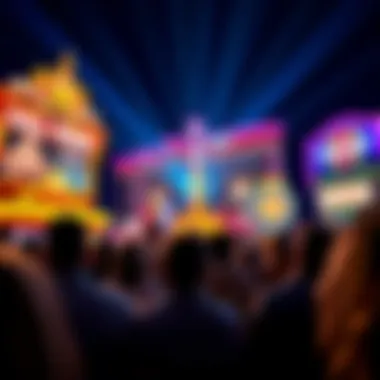
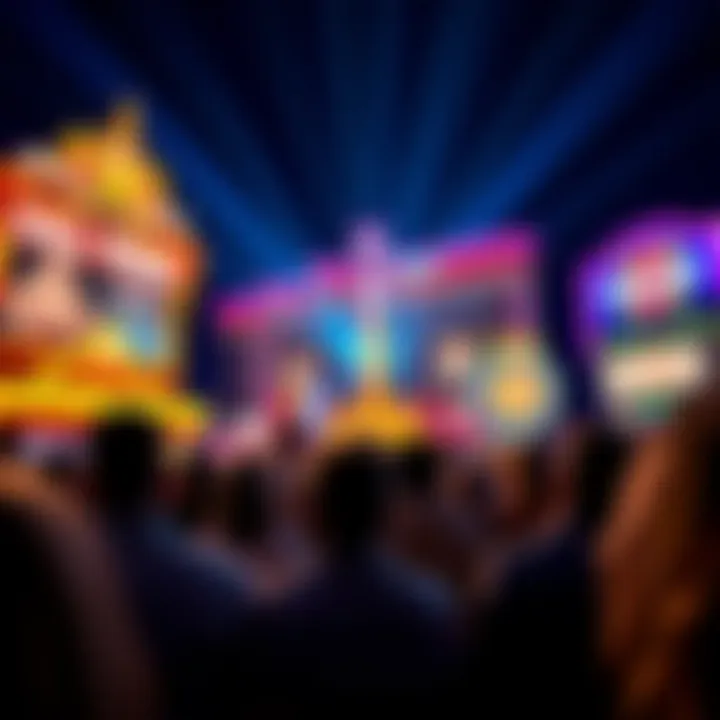
"The legacy of Las Vegas light shows is not only in their view but in the memories they create."
For further information on the evolution of Las Vegas and its iconic light displays, one can refer to resources like Wikipedia or delve deeper into the cultural impacts at Britannica.
Thus, as we navigate through the vibrant and bustling landscape of the Vegas light show phenomenon, acknowledging the historical backdrop enriches our understanding of its significance today.
Artistic Innovations in the Vegas Light Show
The Vegas light show stands as a dazzling testament to artistic innovations that seamlessly blend technology with creativity. In this section, we will delve into how these artistic elements breathe life into the light displays, not only captivating audiences but also reflecting the evolution of art in public spaces.
Integration of Multimedia Elements
Multimedia elements have become the backbone of the Vegas light show, introducing a new layer of engagement for spectators. Gone are the days when lights simply adorned buildings; now, they fuse with audio, video projections, and even interactive components, transforming the overall experience. For instance, Lightscape, a production at the Las Vegas Festival Grounds, combines synchronized visuals with music, allowing visitors to immerse themselves in a sensory environment that feels alive.
Some key aspects of multimedia integration include:
- Visual Storytelling: Projected narratives enhance the light displays, allowing each show to tell a story—often drawing from local culture or global themes. This narrative aspect grips audiences from start to finish.
- Interactivity: Many shows now encourage audience engagement through mobile apps or on-site installations, allowing them to influence the light patterns or music selection. This participatory format has cultivated a new breed of creativity and connection, blurring the line between artist and spectator.
- Diverse Mediums: The use of various artistic mediums—from traditional visual artistry to digital animation and sculpture—fosters an avant-garde environment. Artists can explore new ways to synchronize their works with the lights, creating a dynamic and ever-evolving display.
"The blending of technology with traditional art forms pushes limits previously thought impossible."
With the integration of these multimedia elements, the Vegas light show has not only become a visual extravaganza but also an evolving canvas that invites artists from various disciplines to contribute and collaborate.
Notable Artists and Collaborations
The heart of artistic innovation in the Vegas light show is undoubtedly the contributions of notable artists and their collaborations. Renowned figures are increasingly drawn to Las Vegas, seeking to leave their mark on this glowing metropolis. Artists ranging from local talents to international names have forged partnerships to create uniquely engaging experiences.
Some highlights include:
- David Lynch: Known for his surreal films, Lynch directed a light show that transformed the Las Vegas skyline, exploring the shadows and light in a quintessentially dreamlike manner.
- Moment Factory: This multimedia studio has partnered with various casinos to produce immersive installations that utilize cutting-edge technology, including 3D projection mapping that enchants viewers with a spellbinding narrative.
- Local Artists: Collaboration with local artists not only promotes homegrown talent but also reflects the unique culture and stories of Las Vegas. Such partnerships enrich the fabric of the light show, giving voice to the community.
Each of these collaborations pushes the boundary of what's possible and redefines the relationship between art, technology, and audience experience in the context of a light show. By allowing artists to experiment within this framework, Las Vegas reinforces its position as the quintessential hub for innovation.
Artistic innovations in the Vegas light show underscore its importance not just as entertainment, but as a manifestation of culture, creativity, and technological advancement. These elements combine to create a kaleidoscope of experiences, ensuring that the light shows of Las Vegas remain at the forefront of modern artistic expression.
Technical Aspects of the Light Show
The phenomenal spectacle of the Vegas light show is not simply a visual delight; it is underpinned by a playground of technical ingenuity that continuously pushes the boundaries of entertainment. When one considers the sheer scale and complexity of these displays, understanding the technical aspects becomes crucial to appreciating the art behind it. This section unravels the vital components that make these shows truly captivating, while also highlighting their significant advantages and some considerations that come along.
Lighting Technology: An Overview
Lighting technology in Las Vegas has transformed dramatically over the years. In the past, neon lights were all the rage, illuminating the Strip with vibrant hues. However, as times have changed, so too have the tools and systems used to craft these dazzling displays.
- LED Technology: One of the foremost advancements in lighting technology is the advent of LEDs (light-emitting diodes). LEDs are not just more energy-efficient than traditional bulbs; they offer a greater variety of colors and a more dynamic range of brightness. This enables designers to create intricate visuals that dance and shift, making it seem as if the buildings themselves are alive.
- Projection Mapping: This technique has taken the art of lighting a step further by allowing projection onto building surfaces, showcasing videos and animations in alignment with the architecture. A stunning example is the nightly shows at the Fremont Street Experience, where colorful images bounce off buildings, responding to the beat of music.
- Laser Technology: Lasers add another layer of allure. With their ability to produce sharp, bright beams, they cut through dust and smoke in the atmosphere, resulting in impressive light shows that stretch across the sky. During events like the New Year’s Eve celebrations, lasers create an unforgettable spectacle that's hard to replicate.
"As advancements in lighting technology progress, they open new doors for creativity while keeping the tradition of glitz alive."
Software and Programming Techniques
The artistry behind the light shows is not merely a matter of lighting devices and their placement. The programming that controls these illuminating performances plays an equally critical role. The software applications used in programming these shows can be quite sophisticated.
- Show Control Systems: The backbone of any light show is its control system. Typically, these systems manage the timing, sequencing, and integration of various lighting fixtures. Programs such as LightConverse or Madrix allow technicians to synchronize lights with audio tracks seamlessly, creating an immersive experience for viewers.
- Custom Software Solutions: Many venues opt to build bespoke solutions tailored to the specific requirements of their show. This can include features like lighting adjustments in real time based on crowd reactions or weather conditions. The flexibility of such systems allows tremendous creativity and responsiveness.
- Data Visualization: Some shows rely on data to inform their designs. By harnessing real-time information—such as social media trends or audience feedback—display designs can adapt, ensuring they remain relevant and engaging. This innovative use of technology is an exciting frontier within the realm of entertainment design.
Understanding these technical aspects helps unravel the rich tapestry of the Vegas light show. It's a blend of artistry, engineering, and cutting-edge technology that together creates one of the most stunning spectacles in the world. As we consider the intricate details of lighting technology and programming, one thing becomes clear: the future of the Vegas light show is ever-evolving, and the magic is only just beginning.


Economic Impact of the Vegas Light Show
Las Vegas is not just a city of casinos and nightlife; it’s transformed into a beacon of visual appeal. The economic impact of the Vegas light show can’t be overstated, influencing everything from tourism to job creation. The light shows aren’t mere spectacles; they are a driving force, a magnet for tourists seeking to immerse themselves in the vibrancy of this desert oasis. With each flicker and burst of color, these displays create an atmosphere that elevates the city’s overall appeal and contributes significantly to its economy.
Tourism and Revenue Generation
When it comes to attracting visitors, the glimmering lights of Las Vegas play a pivotal role. According to the Las Vegas Convention and Visitors Authority, millions flock to the Strip each year, eager to witness the dazzling light displays that have become synonymous with Las Vegas. This influx of tourists not only fills hotel rooms but also drives revenue through various sectors such as dining, entertainment, and retail.
The light shows draw audiences for a variety of reasons:
- Unique Experiences: They are unlike anything seen outside of Las Vegas, making them a must-see attraction.
- Social Media Magnet: In the digital age, unique visuals are ripe for sharing. Tourists often post their experiences online, further promoting the city and attracting even more visitors.
"Las Vegas is a prime example of how light can be a catalyst for economic prosperity and cultural enrichment."
Each display can lead to a bump in nearby business revenues, with local shops, restaurants, and casinos benefitting from the increased foot traffic. When tourists are entertained visually and aurally, they're more likely to linger, spend, and return.
Employment Opportunities Created
With the booming tourism sector, it’s no surprise that the Vegas light show industry creates jobs. From the technicians who install the intricate lighting systems to the artists who design breathtaking displays, numerous roles emerge:
- Designers & Artists: These are the creative minds behind the light shows, translating themes and concepts into visual artistry that captivates audiences.
- Technicians & Engineers: Specialized professionals ensure the technical components function flawlessly, maintaining the lights and projection systems.
- Hospitality Roles: Increased tourism creates demand for hotel staff, tour guides, and customer service representatives.
In essence, the light shows not only illuminate the skyline but also brighten the economic prospects for many residents and businesses in Las Vegas. As the city continues to innovate, job opportunities are likely to blossom further, fostering a cycle of growth and creativity that enhances the community's fabric.
Cultural Significance of Light Shows
The light shows in Las Vegas are not just mere entertainment; they symbolize a deeper cultural statement about the city itself. The vibrant displays we see dancing across the night sky reflect a unique fusion of history, artistry, and community identity. Within this section, we will explore how these luminous spectacles serve as a mirror to contemporary art and their crucial role in shaping the identity of the local community.
A Reflection of Contemporary Art
Las Vegas has always marched to the beat of its own drum, and light shows are no exception. They are not just flashy visuals; they encapsulate a journey through current artistic expressions. Artists leverage the dynamic nature of light to challenge perceptions and convey messages.
The use of cutting-edge technology allows creators to merge various art forms, from large-scale installations to video projections, creating a captivating narrative that unfolds in front of an audience. For example, local artists might incorporate elements from classical art movements, such as Impressionism or Modernism, and reinterpret them through a contemporary lens, using light as the chosen medium.
- Zachary Johnson's light installations each tell a story, weaving together local history and contemporary themes, showcasing how art can evolve with technology.
- The annual Las Vegas Arts Festival presents extraordinary light pieces that not only entertain but also provoke thought. Examples can be seen where bright visuals reflect social issues or environmental concerns, integrating the viewer into the dialogue.
These intricate light displays demand active viewer participation and spark conversations, affirming that art is living and breathing.
The Role of Light Shows in Community Identity
In a city known for its casinos, shows, and hustle, light shows play a less obvious but equally important role in uniting the community. They provide a clearer sense of identity, helping locals and visitors alike to connect on a shared cultural platform.
The glowing lights evoke a sense of nostalgia and pride in a city with a rich history. Each display is more than just colors and patterns; it tells stories of resilience, innovation, and aspiration. The connection between the community and these light shows is vast:
- Community Engagement: Many shows involve local talent, creating a sense of belonging and involvement. When a resident sees their neighbor's work illuminated, it fosters pride and community spirit.
- Tourist Attraction: Light shows draw millions of visitors each year. This influx not only boosts the local economy but also showcases the creativity of Las Vegas on a global stage, solidifying its identity.
- Cultural Heritage: Shows often reflect significant cultural events and milestones in Las Vegas history, helping to preserve the narrative of the city for future generations.
Challenges and Controversies
The dazzling light shows of Las Vegas are not merely a feast for the eyes; they also come wrapped in layers of challenges and controversies that warrant a closer look. As entertainment blooms like a garden of neon, there are shadows lurking beneath the vibrance. Environmental issues and the balancing act between heritage and modernity present us with complexities that are as crucial as the light shows themselves. By dissecting these challenges, we gain a better understanding of their implications for the future of Las Vegas as a cultural hub.
Environmental Concerns
One of the pressing challenges surrounding the Vegas light shows is their environmental impact. The city is no stranger to criticisms regarding excessive energy consumption. Las Vegas, with its bright lights illuminating the night sky, uses vast amounts of electricity that could otherwise be conserved. Studies have shown that the city’s commitment to maintaining such elaborate displays contributes to carbon emissions and a larger environmental footprint.
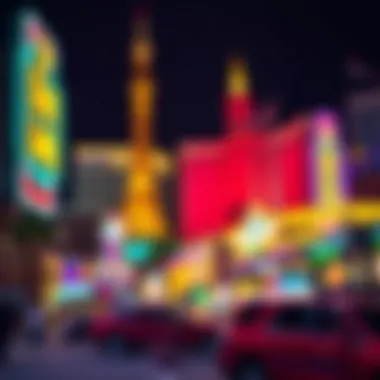
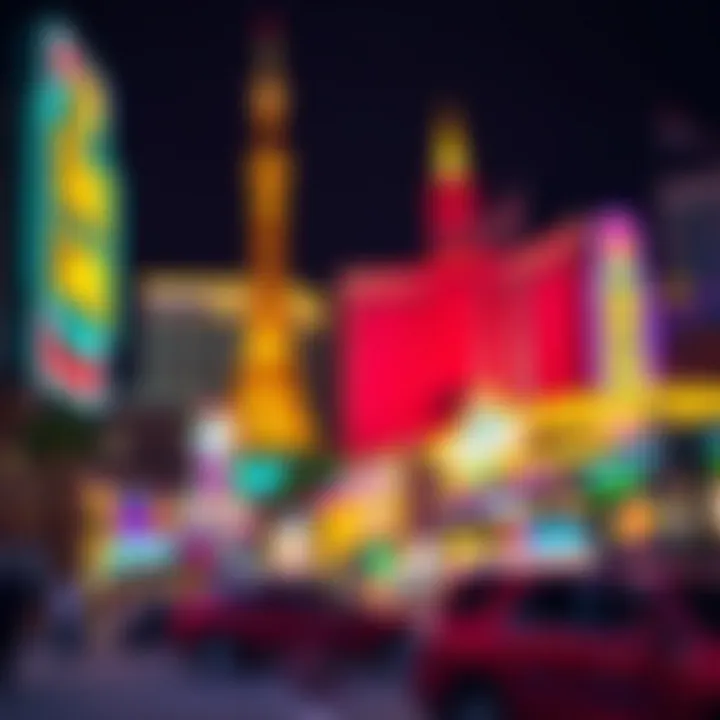
Furthermore, during the scorching summer months, the demand for energy peaks, stretching the grid and compelling city officials to seek out options that are not always environmentally friendly.
- Light Pollution: One stark consequence of these shows is light pollution. It affects not only the nocturnal wildlife that is often displaced by bright lights but also the residents and visitors who may find a peace in natural darkness. As urban sprawl continues, more territories face disturbances from these extravagant shows.
- Resource Allocation: The allocation of resources to fuel these spectacles raises eyebrows. With increasing concerns over water shortages in the desert oasis, some argue that dollars spent on the latest lighting technology could be better invested in sustainable desert farming or renewable energy research.
In light of these issues, some advocates are pushing for greener approaches, such as the use of LED lights, which consume less energy and have a longer lifespan, ultimately benefiting the environment while still delivering the jaw-dropping visuals.
The Balance Between Tradition and Modernity
Another layer of controversy revolves around the balance between tradition and modernity in the light show narrative. Las Vegas, known for its storied history with neon signs, has now made way for high-tech LED displays, which some purists claim jeopardize the city's unique heritage.
While embracing advanced technologies allows for more intricate designs and dynamics, it often sparks debates among locals and historians who cherish the traditional neon lights. This tradition speaks volumes about the city's identity.
- Cultural Heritage: The neon signs served as the face of Las Vegas for decades, representing the dreams and aspirations of those who flocked to the city. Displacing these historical markers for modern equivalents may dilute the cultural fabric that has been painstakingly woven over time.
- Economic Pressures: On the flip side, the introduction of modern lighting technology can be seen as a response to the economic pressures that demand more innovative attractions. In the competitive realm of entertainment, it’s about which city can dazzle visitors most effectively.
"The lights are as much a part of the city as the casinos and the shows themselves; yet, what happens when 'new' becomes 'old' too quickly?"
Finding a solution that respects the past while moving forward is essential for both locals and tourists. Efforts to incorporate traditional aesthetics with modern capabilities may hold the key. By blending old with new, Las Vegas can maintain its image without sacrificing its roots.
The Future of Vegas Light Shows
The future of Vegas light shows is not just a subject of speculation; it’s a glimpse into the dazzling imagination of creators aiming to bring new visions to life. With advancements in technology and changing audience preferences, the Vegas light show is poised on the cusp of a transformation that could redefine entertainment in the heart of the desert. As electric as the neon lights themselves, this evolution calls for a robust exploration of emerging trends and the mantle of sustainability guiding these productions forward.
Emerging Trends and Technologies
Recent years have seen seismic shifts in technology, paving the way for more intricate and engaging light displays. Multiple factors are fueling this momentum. Firstly, augmented reality (AR) and virtual reality (VR) are filtering into light shows. Imagine a fusion of a light display with an interactive experience where spectators can influence the visuals with their movements or choices. Engaging with the light show in such a manner could usher in a fresh wave of multiverse creations, making each visitor part of the spectacle.
Moreover, the rise of 3D mapping technology has taken storytelling to new heights, or depths, dependent on one's perspective. By projecting images on surfaces in real-time, the creative possibilities are seemingly limitless. This evolution has led to intricate narratives coming alive, where iconic landmarks transform into canvases filled with vivid animations.
In addition, the integration of artificial intelligence (AI) is a trend to watch closely. Tailoring light displays to react dynamically to audience participation or even to share tailored narratives creates a personal connection often missing in earlier versions. AI can analyze the atmosphere, noting the enthusiasm of the crowd and adjusting the spectacle accordingly, creating an experience that feels uniquely curated.
"As we look towards the future, the entertainment landscape dwells in symbiosis with technology. Those who adapt will blossom; those who don’t may simply flicker out."
—Entertainment Industry Analyst
Sustainability in Light Show Productions
The growing awareness of environmental issues has inevitably found its way into the realm of entertainment. The light shows of tomorrow will need to address these challenges head-on. Sustainability is no longer merely an option but a necessity. Using LED lights and solar energy can dramatically reduce the carbon footprint of these massive displays. In addition, creating and designing with recyclable materials can further the movement toward eco-friendliness.
Event planners and producers now face not just the challenge of what lights to use but how those decisions impact the planet. The incorporation of green practices into planning and execution is becoming a hallmark of responsible event management. This dedication demonstrates a commitment to not only entertain but to protect the very environment where these dazzling shows unfold.
As the city of Las Vegas grows more integral to discussions about climate action within entertainment, partnerships between casinos, local businesses, and environmental organizations will likely bloom. Innovative initiatives aimed at reducing waste, improving energy efficiency, and enhancing community awareness about sustainability will elevate Vegas light shows not just as entertainment but also as educational platforms.
In revisiting and reshaping the future of light shows in Las Vegas, there’s a blend of creativity and conscientiousness at play. As technology and sustainability intertwine, the skyline will not just shine bright—it will also symbolize a thoughtful approach to modern entertainment.
The End
The Vegas light show stands as more than just a collection of dazzling lights; it is a symbol of the city’s very soul. As we wrap up our exploration of this phenomenon, it’s crucial to recognize the multifaceted nature of the light shows that grace the Las Vegas skyline. These displays embody a rich history, artistic evolution, and complex interplay of technology that has captivated audiences for decades.
Summarizing the Light Show Experience
The experience of witnessing a Vegas light show often transcends mere visual stimulation. The bright, kaleidoscopic lights serve as a tapestry weaving together stories of adventure, aspiration, and the vibrancy of life in Las Vegas. Each performance invites spectators to lose themselves in a world where reality blurs with fantasy. The orchestration of lights, accompanied by pulsating music, creates a sensory immersion that goes beyond what the eye can see.
It's not just about the flash and dazzle; it’s about how these shows can carve out moments of nostalgia and wonder. People from all walks of life—gamblers celebrating wins, couples marking anniversaries, families enjoying a night out—find themselves drawn to these displays. The communal atmosphere adds another layer, as shared gasps and applause weave a common thread among strangers.
The Enduring Legacy of the Vegas Light Show
The legacy of the Vegas light show is undeniably profound. These productions are not just remnants of past entertainment eras; they are living entities that continue to evolve with the times. When one thinks of Las Vegas, the iconic lights are often the first image that springs to mind, symbolizing ambition, glamour, and the allure of chance.
Much like the city itself, the light shows encapsulate the ceaseless pursuit of innovation. New technologies emerge, enhancing the visual language used to engage audiences, while the core essence of spectacle remains unwavering. The ability to adapt and remain relevant speaks volumes about their role in Vegas culture. Furthermore, as the city ventures into sustainability, integrating green technology in these spectacles could shape future traditions.
As we reflect on the importance of the Vegas light show, we acknowledge it as a powerful medium that articulates stories, cultures, and dreams of countless individuals. In essence, light shows will continue to shine as a beacon of Las Vegas, illuminating paths of entertainment, creativity, and community.



